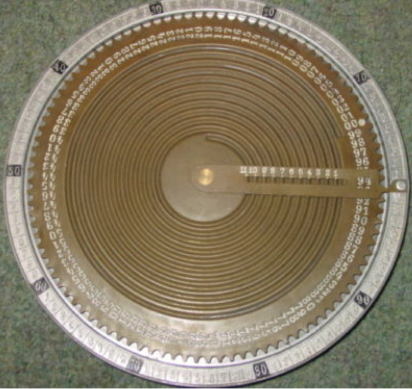
John Wolff describes the Adall calculator rather neatly as follows:
The Adall Calculator
- Single column, addition only
- Direct operation by stylus
- Dimensions: 195mm diameter x 6mm thick, case 210 x 210 x 28mm
- Weight: calculator 190g, with case 440g
- Manufactured: Adall Company, Birmingham, England, 1910–1920s
The Adall Calculator from 1910 is a single-column adding machine based on a hundred-tooth disc. The Adall is presented in a fitted and lined wooden case, with a pocket for a small bone operating stylus.
The mechanism consists only of two concentric discs. The outer (setting) disc of 0.8mm aluminium forms the base of the machine. A ring on the back is slipped over the middle finger so that the machine can be held flat against the palm of the hand. The outer disc is marked anti-clockwise from 0 to 100, with the tens highlighted. The inner (results) disc is marked from 0 to 100, corresponding to the 100 teeth around its outer edge. A flat cross-bar runs from the centre to the zero position on the outer disc to act as a stop. To add, the stylus is placed in the tooth opposite the desired number on the outer setting disc, and the inner disc is pulled clockwise until the stylus reaches the stop. The result appears in the window in the cross-bar.
To count beyond 100, the inner disc is embossed with a deep spiral groove. A steel ball of 1/8” diameter rolls in the groove, and is restrained by a slot in the cross-bar. As the disc turns, the ball travels inwards, so that the hundreds can be read from the scale on the cross-bar. There is no reset mechanism - the inner disc is simply wound backwards for as many turns as necessary at the end of the calculation.
To use the machine to add a list of items in Sterling currency, the pounds, shillings, and pence columns are added separately. When the pence column has been added, a table supplied with the machine is used to convert the total (eg 172d) to 14/4. The 4d is recorded, and the 14 is used to start the addition of the shillings column. Conversion of shillings to pounds (division by 20) is left to mental arithmetic.
The Adall Calculator is described in US Patent 920840, filed by Dreyfus and Levy of Birmingham in 1908. The same principle can be found in much earlier machines - for example, a wooden 100-tooth adder with a spiral carry mechanism is described in US Patent 49168, issued to T.T.Strode in 1865. It is not known whether the Strode device was ever manufactured.
Pages linked to this page
 This work by Jim Falk is licensed under a Creative Commons Attribution-NonCommercial-NoDerivs 3.0 Unported License Click on the logo to the left to see the terms on which you can use it.
This work by Jim Falk is licensed under a Creative Commons Attribution-NonCommercial-NoDerivs 3.0 Unported License Click on the logo to the left to see the terms on which you can use it.